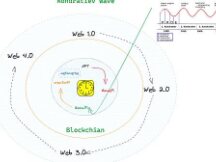What materials are needed to create the metaverse?
The 2021 Metaverse has received a lot of attention. First of all, following meta's "All In" strategy, it was in March and implemented at home and abroad with Microsoft, Nvidia, Baidu, Tencent and ByteDance. In the capital's hype, Metaverse has emerged as the next military expert in the battle, with many companies vying for that big cake.
Throughout the Metaverse, it can be broken down into four categories: hardware, software, services, content, and applications. The most important thing that connects the metaverse and the real world is the hardware. The advanced hardware allows people to have a better knowledge of the Metaverse and the mature Metaverse industry chain. So what material support is needed to build the metaverse?
nti
Crisps are the Metaverse's “staple food”.
On November 9, 2021, NVIDIA announced a major compromise for the industry at its Global Technology Summit GTC. That said, NVIDIA will supply the same technology-based chips to Metaverse in the future. AMD, which develops graphics cards (GPUs), recently launched the Metaverse Trailblazer service. On November 9, AMD announced that Meta (formerly known as Facebook) had become a business partner. In the future, after Meta is replaced by "social media", Meta will buy AMD chips to meet the massive demand for data centers and computing power. The company became a "Metaverse" company. Obligatory.
Creating a metaverse takes a lot of computation and chips can take care of it. AMD CEO Su Zifeng said on Nov 9, “We are stimulating the need for greater inclusion to support the services and products that impact all aspects of our lives during working hours. job.
The rise of VR / AR products will also lead to improved chips, more importantly, and the demand for chips will increase further. Like automotive chips, VR / AR chips have now appeared in cellphones to be more independent and adaptable.
In the past, several technology companies have developed chips specifically for the niche market of VR/AR products. For example, in 2018, Oculus and Xiaomi jointly developed their all-in-one VR product, Oculus Go (known in China as Xiaomi VR All-in-One). In addition, the screen of the Oculus Rift DK2 2014 uses the screen of the Samsung Galaxy Note 3. It can be seen that the first VR/AR hardware relies heavily on devices connected to mobile phones.
However, with the expansion of this industry, existing chains of VR / AR products will still have room for improvement, especially chips. In 2018, Qualcomm also announced the XR 1 chip, a chip designed for VR / AR products. Today, the popular Oculus Quest 2 uses a Qualcomm XR2 (second generation XR 1) chip. Due to the Oculus Quest 2's big eyes, Qualcomm has gradually shifted its focus to the VR / AR industry chain. After the completion of the XR2, it was announced that Qualcomm had developed a joint venture and the team continued to develop chips for VR / AR devices.
On the other hand, big companies like Apple, Meta and Magic Leap hope to continue their own development and refinement of information. According to overseas media, Apple completed the VR/AR chip design in 2020 and commissioned TSMC to develop 5nm advanced process chips. From Qualcomm to Apple, they are attached to the core of the chip, and we expect the chip of VR/AR products to enter a period of rapid development. As this industry continues to grow, more players will join the game in the future. The Metaverse will drive the growth of the chip industry, and the growth of the Metaverse will be driven by the chips.
Virtual reality devices (VR / AR)
Virtual reality is a technology that shows the metaverse to humans. As an important bridge between the real world and change, virtual devices are now being tested and introduced by many organizations, including many large tech companies.
Meta, the "all-in" metaverse, previously released the Oculus lineup. Released in 2020, Oculus Quest 2 was considered the most realistic reality by many popular tech sites. And it only costs $299 per pair of glasses with 1832×1920 resolution (almost the same as 4K high definition). Oculus Quest 2 is arguably the cheapest virtual reality device available today.

Shared marketing of virtual goods
Our bots are tired. Please try later.
With the launch of Oculus Quest 2, Meta grabbed over 75% of the market (delivered in Q1 2021).
In fact, in addition to Meta, Microsoft has its own virtual reality device called HoloLens. Now this has been repeating itself for two generations. HoloLens are true hybrid glasses designed and developed by Microsoft. The price of the second item is $ 3,500, which is slightly different from meta's Oculus Quest 2 in terms of value for money.
There are now rumors that Apple may also be working on a virtual machine which is due out in 2022. Respond to this in the future, it will become a major competitor. In May 2021, Apple acquired virtual reality company NextVR for $ 100 million to support virtual reality capabilities in entertainment and sports.
Our bots are tired. Please try later.
According to IDC data, global VR shipments are expected to grow faster and global VR headset shipments are expected to maintain a CAGR of 41% from 2021 to 2025. Shipments are expected to increase 6.7% million units in 2020 to reach 8.5 million units. in 2021 and 28.6 million units in 2025.

Global VR products screened annually
Source : IDC
As the most important device for teaching humans about the metaverse, virtual devices will have an entire market in the future.
Cloud Representative data center
The functioning of the virtual world cannot be separated from the consumption of electricity, and cloud computing will be realized as humans continue to create the metaverse. The further increase in the volume of data on the Metaverse has resulted in an increase in the demand for energy, and cloud computing is considered one of the most important developments in the Metaverse. Relying on human-computer devices to run metaverse numbers is impossible, and cloud computing is a good solution.
After cloud computing, there is a lot of data center design. Metaverse downloads the program to be counted to the cloud, completes the data, and ultimately returns it to the client. A stronger center of gravity means faster processing, which improves the texture and smoothness of the metaverse.
To log into the metaverse, you must enter "no", such as where to go, what commands to do, etc., just like you would enter commands with the keyboard in sports. The limits at which people enter the metaverse are more difficult than the commands created by typing them with the keyboard. The sensor device writes the "data input", dumps it in the cloud for counting, and then converts it into zero-volume metaverse effects that can be achieved. We can move or put orders in place.
After passing the instructions, the next step is to model the metaverse. All objects, buildings, etc. of the metaverse are virtualized. Nvidia uses RTX ray tracing technology to monitor Huang Renxun using RTX ray tracing technology, interfering with a few seconds of "cheating" online GTC conference Huang Renxun and more than 30 people. The staff took thousands of photos of Huang Renxun and the kitchen from many angles. I do. "Kitchen" is modeled after Omniverse, a virtual integration platform developed by NVIDIA, and ultimately integrated with AI to become virtual reality. The simple design of a kitchen requires a lot of materials to design and simulate, not just the world. Creating realistic and massive metaverse worlds requires powerful cloud technology with powerful simulation capabilities.
People need an "entrance" to connect to the metaverse. After a few counts, the cloud technology sends "recommendations" back to the device in your hand, giving you specific recommendations.
Many tech companies also use related sites. For example, Unity recently launched the “Unity Cloud Distributed Computing Solution”. According to Unity reports, this solution can save up to 70% of the time. It reduces the loss of local supply and reduces costs while improving the efficiency of the entire system.

Unity Cloud technology solutions
5G communication equipment
The main role of the metaverse is to connect with people. One of the advantages of Metaverse is getting low bandwidth, which leads to increased demand for high-speed connectivity, especially 5G.
Older Oculus headsets (like the Oculus Go) were initially built into smartphones to make and count the world, making them heavier, hotter, and less graphics than PCs or consoles could offer. Actually Oculus Quest 2 doesn't need to be connected to a phone, but can do the math on its own, but the texture is still rough. virtual world. Cloud metering can be used to send important data to the cloud and receive the inbound output. And connectivity faster than 5G allows AR / VR devices to capture distant images and deliver faster results to displayed AR / VR devices, such as information and sensing devices. .
Achieving this requires stable latencies of around 7 milliseconds or less and other technologies called advanced mobile computing. It requires an independent 5G network to use this technology.
In the past two years, 5G has become very popular, and many people have discussed the status of the application, and Metaverse will be the mainstay of the application, which shows the strength of 5G. 5G will be a very good metaverse model, and the metaverse will give people a better experience with the rapid improvement of 5G.
All 5G sites in the world today are in decline. Many types of 5G-enabled connectors are needed to create the Metaverse, which is also a challenge that the Metaverse has to overcome when entering ordinary people's homes. For the metaverse to complete the references, it is inextricably linked to a mature 5G infrastructure.

Scan QR code with WeChat






